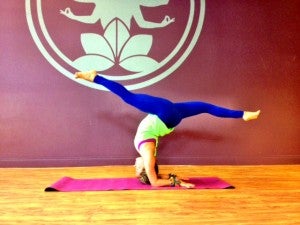“], “filter”: { “nextExceptions”: “img, blockquote, div”, “nextContainsExceptions”: “img, blockquote, a.btn, a.o-button”} }”>
Prenatal yoga can prepare your mind, body, and spirit for motherhood.
When I became pregnant with my son, I couldn’t wait to try prenatal yoga. My pregnancy had been a long time coming, and for years, while struggling with infertility, I’d imagined myself in yoga class with other mamas-to-be, stretched out over a bolster, a hand placed gently on my growing belly. I finally walked into my first prenatal class when I was 12 weeks pregnant, elated but also tired, nauseated, and headachy. Little did I realize that the skills I’d learn there would not only ease the discomforts of pregnancy, but they’d also prepare me for the birth of my son.
Prenatal Yoga 101
Beyond my image of a yoga studio filled with pregnant women, I expected prenatal yoga to be similar to a gentle or restorative class. Prenatal yoga isn’t simply gentle yoga but rather a practice—at times an active, energetic one—uniquely designed for pregnancy, says Britt Fohrman, a prenatal yoga teacher and doula (trained labor assistant) in the San Francisco Bay Area. Restorative poses are an important part of prenatal practice, but most classes include a range of poses that are specifically tailored to pregnant bodies. Classes are often physically challenging and also emotionally supportive.
Having a community and using tools like meditation, visualization, and breathwork help you cope with the myriad physical and emotional changes that pregnancy can bring. And all of the work you do on the mat—building endurance, learning to relax through intense sensations, and coping effectively with stress—serves as powerful preparation for giving birth, too. Many prenatal classes begin with a brief check-in where students have the opportunity to share experiences and challenges from the previous week. From there, classes might move into a centering and breathing exercise, a restorative or body-softening pose, and then through a series of active standing and squatting asanas before ending with restoratives and a period of deep relaxation with props.
For many women, prenatal yoga is the first time they’ve stepped on a yoga mat, but the classes are beneficial for experienced students, too. Although a knowledgeable yoga teacher can modify poses to fit anyone’s needs, you won’t derive the same benefits from a general class. In all likelihood, a hatha yoga teacher without prenatal training won’t have poses like Polar Bear in their back pocket, they won’t be knowledgeable about aches and pains common to pregnancy, and they won’t have the time to prop you in those delicious restorative poses. “A prenatal yoga class will meet the woman where she is,” says childbirth educator and prenatal yoga teacher Jane Austin. For example, instead of doing a low lunge with arms overhead, which can stress your joints during pregnancy, you might be encouraged to do a lunge with your legs wider apart and forearms resting on the floor or on blocks. If you’re pregnant and find yourself needing to modify more than half the poses in your regular yoga class, it’s a good time to make the switch to a prenatal class, says Austin.
See alsoNew Study Finds More Yoga Poses Safe During Pregnancy
Learning to Breathe
The foundation beneath all of the poses in a prenatal class is the breath. Prenatal yoga, says Fohrman, gives you “the opportunity to feel your body and your breath. And your breath is your greatest ally while giving birth.” A deep but gentle belly breath that’s more a rhythmic pulsation than a strong or hard engaging of the abdominals encourages softness and suppleness during class and throughout pregnancy. Austin asks her students to visualize oxygen and energy flowing to the baby as they inhale and to imagine softening the muscles around the pelvic floor as they exhale. Working with the breath this way quells stress hormones and stimulates relaxation.
Breath is fundamental to a prenatal practice, and so is asana. Standing poses practiced with supportive props can help strengthen the legs, ease backaches, build stamina, and instill a sense of confidence for birth and beyond. Prasarita Padottanasana (Wide-Legged Standing Forward Bend) with support under the head can soften and release the muscles around the pelvic floor with the intention of making space for the baby to come through. “In prenatal yoga,” says Austin, “we practice postures specially designed to create suppleness in a woman’s body so she can open when the time comes to birth her baby.”
One-sided squats can increase flexibility in the pelvis prior to labor. Baddha Konasana (Bound Angle Pose) also promotes the quality of release needed during birth.
Restorative poses such as Side-Lying Savasana (Corpse Pose) and Supta Baddha Konasana (Reclining Bound Angle Pose) over bolsters are particularly helpful. These poses are generously propped to give you the chance to get truly comfortable.
Judith Hanson Lasater, yoga teacher, physical therapist, and author of Yoga for Pregnancy and the classic restorative manual Relax and Renew, calls Side-Lying Savasana “the magic elixir” for alleviating the general fatigue that comes along with pregnancy. Lasater suggests pregnant women practice this variation of Savasana every day. She also recommends Cat–Cow stretch for reducing lower back pain. Shoulder openers like Garudasana (Eagle Pose) and arm strengtheners like Goddess Pose arms can help prepare mothers for carrying and nursing their child. Bobby Clennell, a senior teacher at the Iyengar Yoga Institute of New York and author of The Woman’s Yoga Book, adds that practicing Supta Virasana (Reclining Hero Pose) with bolster support can help relieve constipation, assist digestion, and reduce morning sickness.
See alsoSupported Reclined Goddess Pose: Prenatal Yoga How-To
Safety First
In prenatal yoga classes, you shouldn’t encounter poses that are potentially dangerous during pregnancy, such as twists, deep forward or backbends, and poses done on the belly (think Salabhasana or Dhanurasana). There is some disagreement in the yoga community about inversions. Lasater says that we don’t know enough about the effects of going upside down during pregnancy to recommend it. Other teachers, including Clennell and Austin, believe that an experienced yoga student with a longstanding Sirsasana (Headstand) or Sarvangasana (Shoulderstand) practice may safely continue inversions, with proper guidance, during pregnancy. If you’re an experienced student with a longtime inversion practice, the aforementioned poses are thought to help keep your endocrine system running well and may simply feel right for you. The most comfortable and symptom-relieving pose for me midway through pregnancy was a 10-minute variation of Shoulderstand with a chair. (Because your body changes drastically during pregnancy, it’s best to practice these poses at a wall or with props, and to ask your teacher for help the first few times. And be sure to talk to your doctor or midwife before deciding to practice inversions during pregnancy.)
See alsoQ&A: How Can I Modify My More Advanced Practice for Pregnancy?
Relax, Release, Accept
According to Lasater, the biggest benefit of prenatal yoga is learning to relax. Going through pregnancy and its myriad physical and hormonal changes can be exhausting. Natural worries may emerge about your baby’s health, and the imminent transition to parenting can be stressful. A great prenatal yoga class will help you find complete comfort and release, which encourages what’s known as the relaxation response. This healing state creates physiological changes: Your heart rate slows, your blood pressure drops, your breathing becomes deep and rhythmic, and stress hormones such as adrenaline and cortisol dissipate. Once you experience it, you can use yoga techniques to encourage the relaxation response anytime. “Learning to relax deeply is a life skill that could not be more important for a pregnant woman,” says Lasater.
When you’re relaxed, you not only feel less stress but you’re also able to more easily cope with stressors that do arise. This is key during both pregnancy and labor. When you’re faced with the flood of stress hormones that labor generates, the ability to stay calm and relaxed can help you contend with the intensity of the sensations and the decisions that may crop up from moment to moment. Rachel Yellin, a prenatal yoga teacher and childbirth educator, told me that studying prenatal yoga can guide a woman to “recognize when and where she is tense and then consciously let that tension go.” By training your awareness to consciously release tension in class, you can do the same during labor and birth.
Along with cultivating relaxation comes the willingness to surrender to the experience of pregnancy and birth. Ishvara pranidhana, or surrender to a higher source, is a key teaching in Patanjali’s Yoga Sutra, and both Lasater and Austin emphasize it in their classes. “Birthing a baby requires both great effort and the ability to totally let go. We cultivate this on the yoga mat so that we can take it off the mat and into labor and birth,” says Austin. During pregnancy, you might invoke surrender when facing difficult thoughts or emotions: Perhaps you’re fearful about childbirth, worried about your baby’s health, or even disappointed that your pregnancy isn’t as easy or blissful as you’d imagined. During labor, surrender translates to releasing into rather than resisting physical sensations. It means balancing your breathwork, relaxation skills, and concentrated effort with an attitude of surrendering to the outcome.
The quality of surrender can also help you manage difficult emotions that can come if your birth doesn’t go exactly as planned. A recent client of Fohrman’s was an experienced yoga and meditation student who hoped for a drug-free birth attended by midwives. She ended up having a four-day labor resulting in a cesarean birth—and a healthy baby. “She embodied a perfect balance of effort and surrender,” Fohrman says. “She put forth committed effort and practice before the birth and during her labor. We tried everything during those four days, and yet it didn’t go how the parents wanted. But she can look back and know she showed up for that experience. She put in her best effort, and then she surrendered to what is greater, to what she couldn’t understand. She did that so gracefully and stayed in her power. She did everything she could do.”
I didn’t end up with the birth I’d planned either. After many hours of labor, I had to have an emergency cesarean birth. My son was immediately taken to the neonatal intensive care unit (NICU), and I was left alone in a recovery room.
I was overflowing with emotion. Although overjoyed to have given birth, I couldn’t help but feel disappointed in how my birth story had played out, and I was devastated not to have my son in my arms yet. While my husband stayed with our son, I was taken in a wheelchair to my room on a different floor of the hospital and told to rest. After a few hours in my room, I insisted on being wheeled to the NICU to see and nurse my baby.
Perhaps it was the prenatal yoga practice that gave me the fortitude, clear-headedness, and determination to get myself there. The Warrior poses helped build my strength; the chair Shoulderstands kept my hormones balanced; the restorative postures such as Reclining Bound Angle Pose and Reclining Hero Pose infused me with a quiet clarity. As dawn broke, I held my baby in my arms, nursed him for the first time, and sang to him. Looking back at that moment, thinking of the two of us nestled together in a hospital chair, I’m reminded of Yoga Sutra 1.1, Atha yoga anushasanam: Now the teachings of yoga.
See also The Guide to Prenatal Yoga: Everything You Need To Know
Pregnant Pause
Take some time to connect with both your hopes and your fears. Sit in a comfortable position on the floor or in a chair. Breathe deeply for a few minutes, sending your breath to the baby that’s growing inside you. Take a few minutes to think about your hopes and dreams about birth—and about your subsequent journey together as mother and child. Imagine yourself feeling empowered, loved, safe, and being an active participant in your birth. See yourself as a loving parent who knows how to care for your precious child. Notice any positive sensations that arise, and sit with them for a few moments.
Then bring to mind fears or worries you have about birth and parenting. Welcome them into your mind’s field. Acknowledge their presence, and then visualize yourself letting go of them.
Jessica Berger Gross is the editor of About What Was Lost: 20 Writers on Miscarriage, Healing, and Hope. She lives with her husband and their five-year-old son in Brooklyn.
Getting Started
Look for an experienced teacher with specialized training in yoga for pregnancy. Some prenatal teachers have worked not only as yoga instructors but also as doulas, midwives, or childbirth educators. A knowledgeable, seasoned teacher with a passion for pregnancy will help you get the most out of your prenatal practice. She’ll also make sure you avoid twists, backbends, or forward bends that are too deep, overly warm rooms, and generally overdoing your practice.
Strong and Soft: Sequence by Jane Austin
Practice this sequence throughout pregnancy to create strength and suppleness both physically and emotionally. This balance will create more ease throughout your pregnancy and can be helpful during childbirth, too. If you’re short on time, you can do the sequence in 20 minutes. But if you can, give yourself more time to settle in to each pose, to fully work your muscles, and to deeply relax. (Pregnancy is different for everyone: Be sure to get your health-care provider’s OK before you try yoga.)
Virasana (Hero Pose), with Happy Baby Breathing

The inspiration for this practice comes from the tiniest yogis. You try to create the breathing of a content and happy infant: full, deep, and easy. This type of breathing calms the nervous system and increases the flow of oxygen to the uterus, supporting both mom and baby. Many women find it helpful to do happy baby breathing during labor and birth, too.
Come onto hands and knees and place a folded blanket, small pillow, or block between your ankles, then sit back onto your prop. Bring your hands to your belly, and close your eyes. Allow your focus to move inward as you deepen your breath. Root down through your sitting bones as you lengthen your spine and reach the crown of your head up. This will maximize the space inside for your breath and your baby. With each inhalation, feel a sense of fullness as the belly expands. As you exhale, sink your belly gently back toward the spine as though you are giving your baby a hug. Practice for 3 to 5 minutes or longer, if you can.
Virasana (Hero Pose), with Goddess Arms

Mothering requires many hours of baby-holding. This simple pose will stretch and strengthen your upper back, shoulders, and arms to help prepare you.
Inhale and reach your arms out, bending the elbows slightly with your palms facing up. Start by holding this position for 1 or 2 minutes, and work up to holding it for 4 to 5 minutes. The hold is harder than it looks and requires strong mental focus. When you are feeling challenged, it may be helpful to remember that this posture prepares you to hold your sweet baby—they start small, but they grow. Close your eyes and direct your awareness inward. Deepen the breath and visualize your baby floating inside of you. Use happy baby breathing to support you.
When you’re ready, release your arms, hold on to opposite shoulders, and give yourself a massage to relieve tension.
Puppy Pose

Puppy Pose is a close cousin of Adho Mukha Svanasana (Downward-Facing Dog Pose). It’s a good alternative if Down Dog is too strenuous.
Start on hands and knees. If you need to, separate your knees slightly wider than your hips. Ground your shins down, and walk your hands forward until you can rest your forehead on the floor. Press your palms firmly into the floor, keeping your arm bones lifted. Once you’ve found a comfortable pose, draw your ribs in toward your spine, and drop your tailbone slightly. These actions will help you find length in your spine. It is important to not allow your belly to drop toward the floor. Stay for 5 deep breaths.
One-Sided Squats

Some women find a full squat difficult to do during pregnancy, yet squatting is a terrific way to gently open the hips. If you experience any hip discomfort at night, try this pose before going to bed. It may also be helpful to do during labor and birth.
Start on hands and knees. Gently draw your belly back to your spine, and step your right foot forward to the outside of your right hand. As you walk your hands to the left, pivot on your left knee, and move your left foot underneath the buttock. Widen your sitting bones, and lower your hips. As you lower your hips, do not tuck your pelvis. Go only as far down as you can while you keep your sitting bones wide. By doing so, you’ll open your hips.
With your legs in place, press your fingertips into the floor. If you want to go deeper into the pose, bring your forearms down to the floor.

Hold the pose for 1 to 3 minutes, breathing deeply. If you experience compression in your hip joint or feel discomfort in your pubic bone, keep your hips lifted and don’t go as deep into the posture.
To come out of the pose, lift your hips, and come back to hands and knees. Repeat on the other side.
Polar Bear

This is a comfortable alternative to the traditional Child’s Pose: The hips are lifted, making more room for your pregnant belly. The pose’s inverted shape helps take pressure off both the pelvic floor and your spine.
Polar Bear is calming and soothing, allowing you to go deep inside yourself.You can do it during labor as a refueling time or during your yoga practice as a time to connect to your baby and yourself.
From hands and knees, bring your forearms down to the floor, knees hip distance apart or slightly wider to make room for your baby. Press your forearms into the floor, and release your head down. Visualize your baby resting in your belly, which is like a hammock. Stay for at least 5 breaths.
Virabhadrasana II (Warrior Pose II), variation

With tongue firmly planted in cheek, I like to call this pose “Mama Protector Don’t Mess with My Baby Pose.” There are many times when you’ll be called to protect even your tiniest baby from other people’s opinions and advice. This pose can help you cultivate the quiet strength you’ll need.
Stand tall, reach your arms out to the sides, and step your feet wide with ankles directly under the wrists. Turn your right foot out and your left toes in. Inhale, lengthen your spine. Exhale, bend your right knee, gazing over your right hand.
Rotate your palms up, and lift your right hand 3 to 4 inches. Bend your left elbow; pull it back and down. Release your shoulders away from your ears, and soften all the muscles of your face. This is a powerful pose. A mama protecting her young is fierce and strong but also soft.
After 5 deep breaths, come up and do on the other side.
Horse Pose with Goddess Arms

Step your feet wide apart. Inhale, lengthen your spine, exhale, and bend your knees. See that your knees are directly over your ankles and are not rolling inward but tracking toward the pinkie toe side of the foot. Lift your arms out to the sides with palms facing up, and bend your elbows. Preserve the natural curves of your spine: Draw your front ribs toward your spine to avoid overarching your low back. Don’t tuck your pelvis either, which can flatten your lower back. Aim for a soft, gentle curve in the lower spine.
Hold the pose for 1 to 4 minutes. See your baby inside of you, and deepen your breath. If your back starts to strain, straighten your legs and rest. With practice, your back and legs will get stronger. Listen to your body and take a break when you need it.
You’re pregnant and want to try prenatal yoga. When do you begin? And how do you find a teacher? Some women in their first trimester discover that a mostly restorative practice helps with fatigue and morning sickness. But most women, particularly those with a history of miscarriage or infertility, choose to wait until the end of their first trimester to start or return to yoga and try their first prenatal class.
Corpse Pose (Side-Lying Savasana)

Lie on whichever side feels more comfortable to you with a folded blanket or a pillow underneath your head. Place a bolster or a large, firm pillow beside your right leg. Then bend your left knee, and place your left leg on the bolster. Keep the knee and the ankle as high as your left hip with your hips square. Close your eyes. Allow your breath to wash over you and feel yourself letting go of tension. Stay for 7 to 10 minutes, imagining your baby resting with you.
See alsoGiggles and Gomukhasana: Teaching Parent-Baby Yoga Classes

